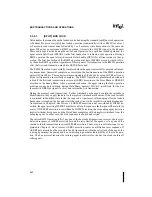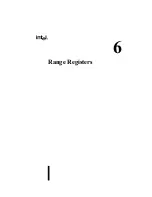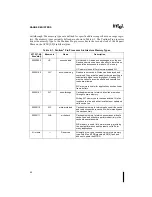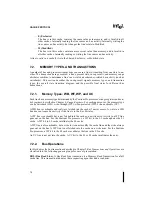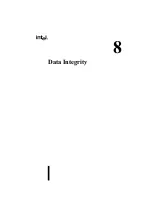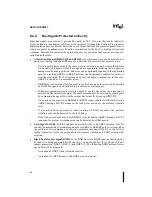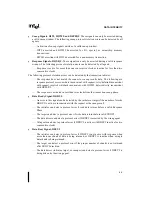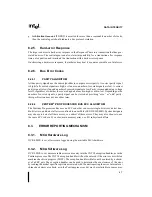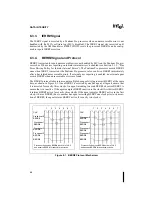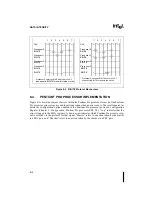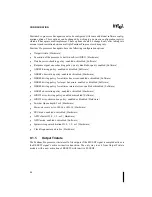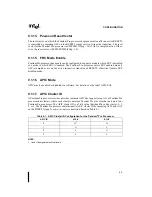
8-4
DATA INTEGRITY
8.2.2.
Bus Signals Protected Indirectly
Some bus signals are not directly protected by parity or ECC. However, they can be indirectly
protected due to a requirement to follow a strict protocol. Although the Pentium Pro processor
implementation does not directly detect the errors, future Pentium Pro processor generations or
other bus agents can enhance error detection or correction for the bus by checking for protocol
violations. Pentium Pro processor bus protocol errors are treated as fatal errors unless specifi-
cally stated otherwise.
•
Arbitration Signals BREQ[3:0]# and BPRI#. Any arbitration error can be detected as a
parity error during the Request Phase or as a Pentium Pro processor bus protocol error:
— If two request phases occur in the same cycle (a collision), a parity error in the address
is detected by all agents. All of these signals are open-drain, ensuring that no physical
damage results from a collision. The error can be optionally reported to the requesting
agent by asserting AERR#. (AERR# protocol can be optionally enabled for retries to
reset the arbitration ID of all symmetric agents and begin re-arbitration. In this case,
AERR# is treated as a recoverable error.)
— If BREQn# is deasserted while the agent is not the bus owner, the error can be detected
by all the bus agents as a Pentium Pro processor bus protocol error.
— If Request generation occurs while the agent is not the bus owner, the error can be
detected by the current bus owner. The same error can also be detected by other agents
by comparing the agent ID with the current bus owner ID driven on DID[7:0]#.
— If a non-lock driver activates BREQn# or BPRI# sooner than the fourth clock after an
AERR# during a LOCK# sequence, the lock driver can detect the protocol violation
error.
— If a non-lock driver generates a request during a LOCK# sequence, the protocol
violation error can be detected by the lock driver.
— If the lock driver does not activate BREQn# two clocks after AERR# during a LOCK#
sequence, the protocol violation error can be detected by all bus agents.
•
Lock Signal LOCK#. LOCK# can only be asserted with a valid ADS# assertion. LOCK#
can only be deasserted after sampling an active AERR# or DEFER# in the first locked bus
transaction, or after sampling a successful completion response RS[2:0]# on the last bus
locked transaction. All bus agents can detect a protocol violation on LOCK# assertion/de-
assertion.
•
Block Next Request Signal, BNR#. In the BNR-free state, BNR# must be inactive when
no request is being generated (ADS# inactive), or during the first three clocks of a new
request generation (ADS#, ADS#+1, and ADS#+2). The following BNR# protocol errors
can be detected by all agents.
— Activation of BNR# when it must be inactive.
— Activation of ADS# during a valid BNR# assertion request.
Summary of Contents for Pentium Pro Family
Page 17: ...1 Component Introduction ...
Page 26: ...2 Pentium Pro Processor Architecture Overview ...
Page 27: ......
Page 36: ...3 Bus Overview ...
Page 62: ...4 Bus Protocol ...
Page 105: ...5 Bus Transactions and Operations ...
Page 126: ...6 Range Registers ...
Page 131: ...7 Cache Protocol ...
Page 135: ...8 Data Integrity ...
Page 148: ...9 Configuration ...
Page 161: ...10 Pentium Pro Processor Test Access Port TAP ...
Page 172: ...11 Electrical Specifications ...
Page 201: ...12 GTL Interface Specification ...
Page 229: ...13 3 3V Tolerant Signal Quality Specifications ...
Page 233: ...14 Thermal Specifications ...
Page 239: ...15 Mechanical Specifications ...
Page 241: ...15 2 MECHANICAL SPECIFICATIONS s Figure 15 1 Package Dimensions Bottom View ...
Page 252: ...16 Tools ...
Page 260: ...16 8 TOOLS Figure 16 4 Generic MP System Layout for Debug Port Connection ...
Page 264: ...17 OverDrive Processor Socket Specification ...
Page 290: ...A Signals Reference ...
Page 320: ...Index ...
Page 328: ......

